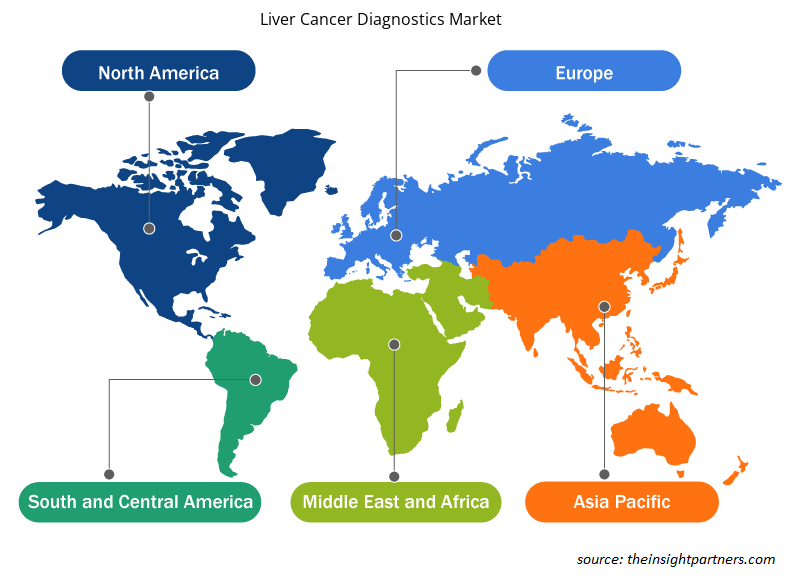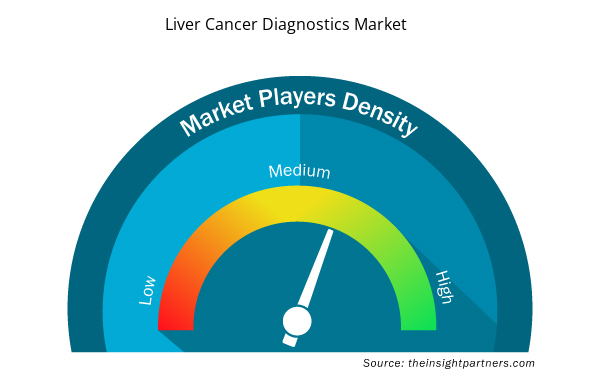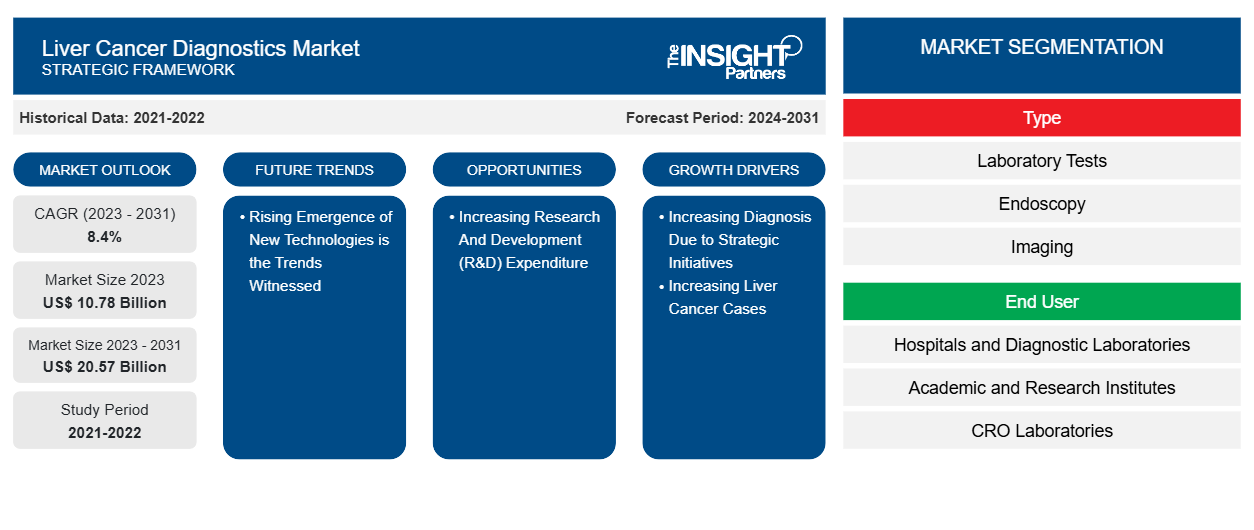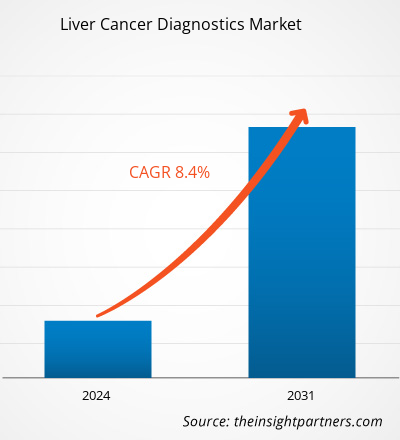肝臓がん診断市場の規模は、2023年の107億8,000万米ドルから2031年には205億7,000万米ドルに達すると予測されています。市場は2023年から2031年の間に8.4%のCAGRを記録すると予想されています。新しい技術の出現の増加は、市場の主要なトレンドであり続けると思われます。
肝臓がん診断市場分析
CDC によると、米国では毎年、男性約 24,500 人、女性約 10,000 人が肝臓がんを発症し、そのうち男性 18,600 人、女性 9,000 人がこの病気で亡くなっています。米国人の肝臓がん発症件数はここ数十年増加しています。肝細胞がん (HCC) は米国で最も一般的な肝臓がんです。さらに、カナダ政府によると、カナダの成人の約 4 人に 1 人 (26.6%) が現在肥満です。肥満件数も増加しており、増加するにつれて肝臓障害、糖尿病、高血圧、心臓病などの特定の健康状態のリスクも増加しています。
肝臓がん診断市場の概要
2020年、世界保健機関(WHO)は、世界中で1000万人以上が死亡し、そのうち6人に1人ががんで死亡していると述べています。また、2020年には肝臓がんが最も一般的ながんの種類の1つであり、すべての新規がん症例の約4.7%、すべてのがんによる死亡の8.3%を占めています。診断されたすべての肝臓がん症例のうち、75%から90%は肝細胞がん(HCC)であり、がん関連死亡にさらに重大な影響を及ぼしています。CCO(中国臨床腫瘍学)に掲載された記事によると、肝細胞がん(HCC)は世界中でがんによる死亡の主な原因です。HCCスクリーニングに最もよく使用される手順は、血清アルファフェトプロテイン(AFP)検査と肝臓超音波検査です。ただし、感度で見ると、AFP検査の感度は25%から65%であり、超音波の感度は60%以上です。肝臓がんはより一般的ながんであり、症例数も増加しています。たとえば、英国では、肝細胞がんによる死亡率は 2025 年までに 14% 上昇すると予想されており、これはあらゆるがんの中で最も大きな増加率となります。
要件に合わせてレポートをカスタマイズする
このレポートの一部、国レベルの分析、Excelデータパックなど、あらゆるレポートを無料でカスタマイズできます。また、スタートアップや大学向けのお得なオファーや割引もご利用いただけます。
- このレポートの主要な市場動向を入手してください。この無料サンプルには、市場動向から見積もりや予測に至るまでのデータ分析が含まれます。
肝臓がん診断市場の推進要因と機会
市場を有利にする戦略的取り組みにより診断が増加
2020年6月、NCIの科学者らは、肝臓がんの最も一般的な形態である肝細胞がん(HCC)をスクリーニングするための新しい検査法を開発しました。このスクリーニングには、患者の特定のウイルスへの過去の曝露を調べるための血液検査が含まれます。このようなスクリーニングは、主に末期または進行期のがんが検出され、その時点では治癒不可能な場合が多いため、早期発見と診断につながります。さらに、NCIは、HCC患者の転帰を改善することを目的として、早期発見、診断、治療のための新しい方法を開発するためのCCR肝臓がんプログラムも立ち上げました。さらに、国立衛生研究所(NIH)は、有望な新しいがんスクリーニング技術の可能性のある利点と問題を評価し、これらの革新を標準治療プロトコルに統合するための効率的な方法を管理するための臨床試験ネットワークを開始しました。
研究開発費の増加
2021年のElecsys GALAD研究開発(R&D)支出は146億5,000万米ドルで、2020年は131億7,000万米ドルでした。コアベースで14%増加しました。さらに、F.ホフマン・ラ・ロシュ社のR&Dは、腫瘍学、眼科、パーソナライズされたヘルスケアへの後期投資を中心に増加しました。さらに、2020年6月、国立衛生研究所(NIH)の科学者は、国立がん研究所(NCI)の研究者が管理する肝臓がんスクリーニングを改善するための血液検査を開始しました。したがって、肝臓がんの診断テストに対するR&D投資の増加と開発が、肝臓がん診断市場を牽引しています。
肝臓がん診断市場レポートのセグメンテーション分析
肝臓がん診断市場分析の導出に貢献した主要なセグメントは、タイプとエンドユーザーです。
- タイプに基づいて、市場は臨床検査、内視鏡検査、画像診断、生検、その他に分類されます。臨床検査セグメントは2023年に大きな市場シェアを占めました。
- エンドユーザーに基づいて、市場は病院と診断研究所、学術研究機関、CRO研究所に分かれています。病院と診断研究所のセグメントは、2023年に大きな市場シェアを占めました。
肝臓がん診断市場シェアの地域別分析
肝臓がん診断市場レポートの地理的範囲は、主に北米、アジア太平洋、ヨーロッパ、中東およびアフリカ、南米および中米の 5 つの地域に分かれています。
北米が市場を支配しており、今後数年間はアジア太平洋地域が最高のCAGRで成長すると予想されています。アジア太平洋市場の成長は、高齢者人口の増加と肝臓がんの治療オプションの拡大によるものです。インドや中国などの国で肝臓がんの診断手順が改善されたため、アジア太平洋地域は最高のCAGRを示すことが予想されています。診断ソリューションの費用対効果が向上するにつれて、アジア太平洋地域の独立した診断ラボでの肝臓がん診断の需要が高まると予想されます。上記の要因が肝臓がん診断市場を推進するでしょう。
肝臓がん診断市場の地域別分析
予測期間を通じて肝臓がん診断市場に影響を与える地域的な傾向と要因は、Insight Partners のアナリストによって徹底的に説明されています。このセクションでは、北米、ヨーロッパ、アジア太平洋、中東およびアフリカ、南米および中米にわたる肝臓がん診断市場のセグメントと地理についても説明します。

- 肝臓がん診断市場の地域別データを入手
肝臓がん診断市場レポートの範囲
| レポート属性 | 詳細 |
|---|---|
| 2023年の市場規模 | 107.8億米ドル |
| 2031年までの市場規模 | 205億7000万米ドル |
| 世界のCAGR(2023年~2031年) | 8.4% |
| 履歴データ | 2021-2022 |
| 予測期間 | 2024-2031 |
| 対象セグメント | タイプ別
|
| 対象地域と国 | 北米
|
| 市場リーダーと主要企業プロフィール |
|
肝臓がん診断市場のプレーヤー密度:ビジネスダイナミクスへの影響を理解する
肝臓がん診断市場は、消費者の嗜好の変化、技術の進歩、製品の利点に対する認識の高まりなどの要因により、エンドユーザーの需要が高まり、急速に成長しています。需要が高まるにつれて、企業は提供を拡大し、消費者のニーズを満たすために革新し、新たなトレンドを活用し、市場の成長をさらに促進しています。
市場プレーヤー密度とは、特定の市場または業界内で活動している企業または会社の分布を指します。これは、特定の市場スペースに、その市場規模または総市場価値に対してどれだけの競合相手 (市場プレーヤー) が存在するかを示します。
肝臓がん診断市場で事業を展開している主要企業は次のとおりです。
- アボット、
- ビオメリューSA、
- F. ホフマン・ラ・ロッシュ株式会社
- イルミナ株式会社
- フィリップスNV社、
- キアゲン、
免責事項:上記の企業は、特定の順序でランク付けされていません。

- 肝臓がん診断市場のトップキープレーヤーの概要を入手
肝臓がん診断市場のニュースと最近の動向
肝臓がん診断市場は、主要な企業出版物、協会データ、データベースを含む一次調査および二次調査後の定性的および定量的データを収集することによって評価されます。肝臓がん診断市場の動向のいくつかを以下に示します。
- Illumina, Inc. は、複数の腫瘍遺伝子とバイオマーカーを評価する TruSight 腫瘍学検査を開始しました。TruSight 検査は、まもなくヨーロッパで世界的に開始されます。この検査は、腫瘍遺伝子とバイオマーカーを評価して患者のがんの特定の分子プロファイルを発見し、精密医療の決定に役立ちます。(出典: Illumina, Inc.、プレスリリース、2022 年 3 月)
- Perspectum は HepQuant と提携し、Perspectum の契約研究機関 (CRO) サービスを通じて HepQuant の肝機能評価技術の提供を開始しました。この提携により、肝硬変、非アルコール性脂肪肝炎 (NASH)、自己免疫性肝疾患、肝臓がんなどの肝疾患の臨床試験を支援する製薬会社は、Perspectum の Pharma Solutions から画像診断および機能検査の知識を受け取ることができるようになりました。(出典: Perspectum、プレスリリース、2021 年 11 月)
肝臓がん診断市場レポートの対象範囲と成果物
「肝臓がん診断市場の規模と予測(2021〜2031年)」レポートでは、以下の分野をカバーする市場の詳細な分析を提供しています。
- 肝癌診断市場の規模と予測(対象範囲に含まれるすべての主要市場セグメントについて、世界、地域、国レベルで)
- 肝臓がん診断市場の動向、および推進要因、制約、主要な機会などの市場動向
- 詳細なPEST/ポーターの5つの力とSWOT分析
- 肝臓がん診断市場分析では、主要な市場動向、世界および地域の枠組み、主要プレーヤー、規制、最近の市場動向を取り上げています3
- 市場集中、ヒートマップ分析、主要プレーヤー、肝臓がん診断市場の最近の動向を網羅した業界の状況と競争分析
- 詳細な企業プロフィール
- 過去2年間の分析、基準年、CAGRによる予測(7年間)
- PEST分析とSWOT分析
- 市場規模価値/数量 - 世界、地域、国
- 業界と競争環境
- Excel データセット



Report Coverage
Revenue forecast, Company Analysis, Industry landscape, Growth factors, and Trends

Segment Covered
This text is related
to segments covered.

Regional Scope
North America, Europe, Asia Pacific, Middle East & Africa, South & Central America

Country Scope
This text is related
to country scope.
よくある質問
North America has dominated the Liver Cancer Diagnostics market.
Factors such as increasing diagnosis due to strategic initiatives and incasering liver cancer cases will boost the market growth.
The rising emergence of new technologies is likely to remain a key trend in the market.
The liver cancer diagnostics market size is projected to reach US$ 20.57 billion by 2031.
The market is expected to register a CAGR of 8.4% during 2023–2031.
Trends and growth analysis reports related to Life Sciences : READ MORE..
The Insight Partners performs research in 4 major stages: Data Collection & Secondary Research, Primary Research, Data Analysis and Data Triangulation & Final Review.
- Data Collection and Secondary Research:
As a market research and consulting firm operating from a decade, we have published and advised several client across the globe. First step for any study will start with an assessment of currently available data and insights from existing reports. Further, historical and current market information is collected from Investor Presentations, Annual Reports, SEC Filings, etc., and other information related to company’s performance and market positioning are gathered from Paid Databases (Factiva, Hoovers, and Reuters) and various other publications available in public domain.
Several associations trade associates, technical forums, institutes, societies and organization are accessed to gain technical as well as market related insights through their publications such as research papers, blogs and press releases related to the studies are referred to get cues about the market. Further, white papers, journals, magazines, and other news articles published in last 3 years are scrutinized and analyzed to understand the current market trends.
- Primary Research:
The primarily interview analysis comprise of data obtained from industry participants interview and answers to survey questions gathered by in-house primary team.
For primary research, interviews are conducted with industry experts/CEOs/Marketing Managers/VPs/Subject Matter Experts from both demand and supply side to get a 360-degree view of the market. The primary team conducts several interviews based on the complexity of the markets to understand the various market trends and dynamics which makes research more credible and precise.
A typical research interview fulfils the following functions:
- Provides first-hand information on the market size, market trends, growth trends, competitive landscape, and outlook
- Validates and strengthens in-house secondary research findings
- Develops the analysis team’s expertise and market understanding
Primary research involves email interactions and telephone interviews for each market, category, segment, and sub-segment across geographies. The participants who typically take part in such a process include, but are not limited to:
- Industry participants: VPs, business development managers, market intelligence managers and national sales managers
- Outside experts: Valuation experts, research analysts and key opinion leaders specializing in the electronics and semiconductor industry.
Below is the breakup of our primary respondents by company, designation, and region:

Once we receive the confirmation from primary research sources or primary respondents, we finalize the base year market estimation and forecast the data as per the macroeconomic and microeconomic factors assessed during data collection.
- Data Analysis:
Once data is validated through both secondary as well as primary respondents, we finalize the market estimations by hypothesis formulation and factor analysis at regional and country level.
- Macro-Economic Factor Analysis:
We analyse macroeconomic indicators such the gross domestic product (GDP), increase in the demand for goods and services across industries, technological advancement, regional economic growth, governmental policies, the influence of COVID-19, PEST analysis, and other aspects. This analysis aids in setting benchmarks for various nations/regions and approximating market splits. Additionally, the general trend of the aforementioned components aid in determining the market's development possibilities.
- Country Level Data:
Various factors that are especially aligned to the country are taken into account to determine the market size for a certain area and country, including the presence of vendors, such as headquarters and offices, the country's GDP, demand patterns, and industry growth. To comprehend the market dynamics for the nation, a number of growth variables, inhibitors, application areas, and current market trends are researched. The aforementioned elements aid in determining the country's overall market's growth potential.
- Company Profile:
The “Table of Contents” is formulated by listing and analyzing more than 25 - 30 companies operating in the market ecosystem across geographies. However, we profile only 10 companies as a standard practice in our syndicate reports. These 10 companies comprise leading, emerging, and regional players. Nonetheless, our analysis is not restricted to the 10 listed companies, we also analyze other companies present in the market to develop a holistic view and understand the prevailing trends. The “Company Profiles” section in the report covers key facts, business description, products & services, financial information, SWOT analysis, and key developments. The financial information presented is extracted from the annual reports and official documents of the publicly listed companies. Upon collecting the information for the sections of respective companies, we verify them via various primary sources and then compile the data in respective company profiles. The company level information helps us in deriving the base number as well as in forecasting the market size.
- Developing Base Number:
Aggregation of sales statistics (2020-2022) and macro-economic factor, and other secondary and primary research insights are utilized to arrive at base number and related market shares for 2022. The data gaps are identified in this step and relevant market data is analyzed, collected from paid primary interviews or databases. On finalizing the base year market size, forecasts are developed on the basis of macro-economic, industry and market growth factors and company level analysis.
- Data Triangulation and Final Review:
The market findings and base year market size calculations are validated from supply as well as demand side. Demand side validations are based on macro-economic factor analysis and benchmarks for respective regions and countries. In case of supply side validations, revenues of major companies are estimated (in case not available) based on industry benchmark, approximate number of employees, product portfolio, and primary interviews revenues are gathered. Further revenue from target product/service segment is assessed to avoid overshooting of market statistics. In case of heavy deviations between supply and demand side values, all thes steps are repeated to achieve synchronization.
We follow an iterative model, wherein we share our research findings with Subject Matter Experts (SME’s) and Key Opinion Leaders (KOLs) until consensus view of the market is not formulated – this model negates any drastic deviation in the opinions of experts. Only validated and universally acceptable research findings are quoted in our reports.
We have important check points that we use to validate our research findings – which we call – data triangulation, where we validate the information, we generate from secondary sources with primary interviews and then we re-validate with our internal data bases and Subject matter experts. This comprehensive model enables us to deliver high quality, reliable data in shortest possible time.


 このレポートの無料サンプルを入手する
このレポートの無料サンプルを入手する